From Candombe to N2: A Tradition of Uruguayan Music Taking the Street, Virtually or Otherwise
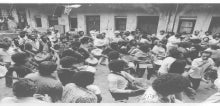
Image courtesy of casaafrouruguaya.org
In 2005, Jorge Drexler won an Academy Award for best original song, “Al otro lado del río”, the first song in Spanish to do so. There was some controversy surrounding the event, to say the least. He was not allowed to perform his own song at the ceremony, and when he was announced as the winner, he jovially walked onto the stage, showed deference to Prince, the presenter, and then proceeded to sing the chorus of his song a cappella as his acceptance speech, ending it with a “ciao”.
Due to the initial polemic, this has been appreciated as an eloquent and elegant act of rebellion, although in an interview with Lalo Mir, Drexler jocosely stated that he just didn’t think he was going to win and so didn’t have a speech prepared. Nonetheless, his actions at the Academy Awards form part of a tradition of resistance via music in Uruguay. Jorge Drexler inherited this tradition and carried it over onto a virtual platform. In 2012, Drexler created a tablet/mobile application called N, or as he coined it, an aplicanción. It is a play on words in Spanish between “aplicación” and “canción”. The song-app consists of three songs with a base structure that invites the User to determine the direction he/she will take the song.
In N1 and N3, the user chooses the lyrics of the song, and in N2 the user orchestrates the music. Due to time and spatial constraints, this post will focus specifically on N2, “Madera de deriva” (Driftwood). The aplicanción via GPS locates the user (asks for permission beforehand) and depending on his/her geolocation opens one of the twelve musical sections of the song at random and indicates which direction to walk to and how far to go to open another, up to 500 meters. While the music plays, the User orchestrates the available sections at his/her will until finally opening-up all of the twelve possible.
The act of making music in N is used as a vehicle to connect the User to the world. One must experience the time and space of the location to understand it past the level of merely information. It can be whenever time at whichever latitude and longitude in whatever neighborhood, but that says nothing of the uniqueness of the place nor the User’s circumstances there when they happen to coincide. The relations between the resident of a space and the visitor are broken down and how the User really feels about the people and locations confronted becomes conscious and evident to him/her. N2 leaves the User accountable in the real world through the virtual platform provided by the media by taking him/her to the street and making them interact with it.
Spontaneous manifestations of music on the street are a common occurrence in Montevideo, Uruguay. At random hours throughout the day and night, people gather in groups and dance around neighborhoods, playing the drums, and drinking yerba mate. As quaint and folklorizing as that sounds, in Uruguay and especially in Montevideo, there is a long standing tradition of resistance by taking to the street in song. This custom is born out of candombe, and understanding candombe’s significance in Uruguayan culture gives a more informed understanding of Drexler’s acceptance speech and N.
Candombe is an Afro-Uruguayan musical style and dance, centered around drums, and performed by groups called comparsas. It has its roots with the African slaves forcefully taken to Uruguay during the colonial period and slightly into independence. As a word, candombe is employed as a qualifier to express all that is tied to Afro-Uruguayan culture, often-times pejoratively as an all-encompassing “cosa de negros” (thing of blacks). Despite it being brandished as a racially disparaging qualification, this has never dissuaded non-Afro-Uruguayan interest in candombe, but it does complicate it. At first it was a religious ritual from Africa that was later re-signified and employed during Catholic festivities, which today has translated into Carnaval in Uruguay. That fact is in itself a testament to how the Afro-Uruguayan community has negotiated the survival of their traditions into today’s Uruguayan culture. Candombe then as a practice manages to endure and becomes a stalwart for Afro-Uruguayan community organization and expression. As a marginalized group, that was their way of opening a space for themselves in public places outside of a work environment where they were typically consigned to military service and menial jobs. However, there in the performance they literally take the street, “ganar la calle”, and in song and dance exist in the face of discriminatory circumstances. The lyrics of candombes through the Nineteenth and Twentieth centuries have a history of manifesting discontent with those conditions, denouncing the practically forced military service of the Nineteenth century and the limited opportunities for work that seems to be a perpetual state of affairs to this day.
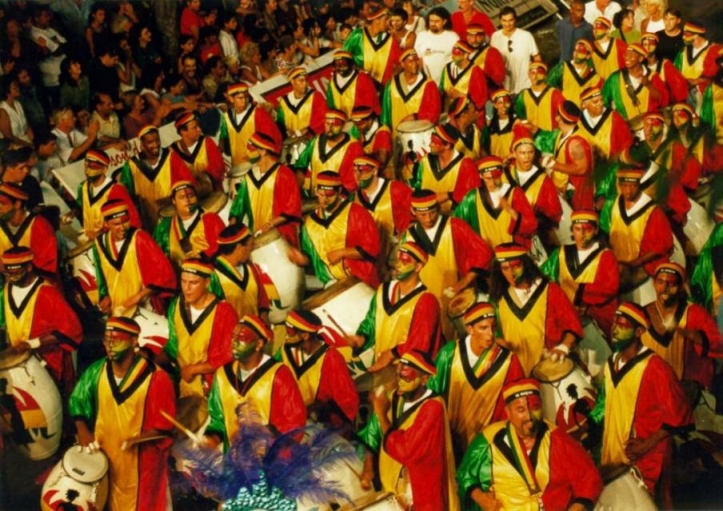
Image in public domain, courtesy of Wikipedia
Candombe also went beyond the holidays. Due to the segregation and grouping of the Afro-Uruguayan population, in the Twentieth century they were put in conventillos, which would more or less translate into housing projects. These conventillos have helped the formation of the candombe’s culture. Impromptu performances by comparsas are initiated by a llamada. That call consists of someone going out into the street and beginning to play the drums. Whosoever answers the llamada recognizes the drumming for what it is and is invited to form part of the comparsa’s performance. The intimacy behind a call, to ask if another is there and have the call recognized and answered is indicative of the solidarity in the improvised community that is created.
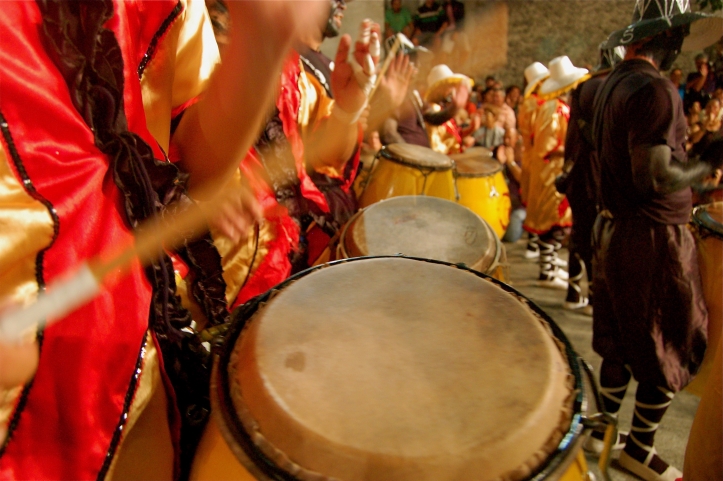
Image in public domain, courtesy of Wikipedia
The evolution of candombe begins with the Salas de Naciones, which were comprised of similar African ethnic groups during the years of slavery that would gather together when permitted; later with the Sociedades, which were organizations formed after abolition; and then to the conventillos or barrios where they were relegated to in the beginning of the 20th century only to be torn down during the years (1973-85) of civic-military dictatorship[i]. During each time period, the communal organization always sought to support other members of the Afro-Uruguayan community and reinforce that history of their past. Suppressing the ethnic African diversity minimizes its visibility within the Uruguayan culture, homogenizing an already discriminated people in an effort to make them less distinctive and eliminate whatever history they might have brought with them to Uruguay. To this day, comparsas identify with a specific barrio where the conventillo was from, the housing projects that are themselves a vestige of the initial resistance and struggle experienced by the naciones. Visually, the colors that form part of the spectacle of the comparsas are one of the indicators of that history, but the greater distinction is found in musical dynamics of the drumming. The rhythm and time developed by each comparsa is a marker for a nación (Ferreira 131). In the drumming of the candombe performances are inscribed the multiethnic Afro-Uruguayan history of Uruguay that has been discriminated against to bolster the official Euro-Uruguayan discourse.
The invisibilization of the Afro-Uruguayan community, despite candombe’s general acceptance in Uruguay, is a result of the Eurocentric historical emphasis the country has been propagating. About a quarter into the 20th century, El libro del centenario del Uruguay declares that the country is populated by a race of European descendants, the indigenous people have disappeared, and the “Ethiopian race, brought to the country by the Spanish conquerors from the African continent to serve as slaves, has visibly declined, to the point of constituting an insignificant percentage of the total population” (Andrews 3). Andrews finds that the textbooks used in schools from the 1920s to the 1960s had two recurring themes: “the uniquely democratic character of Uruguayan politics and society, and the importance of European immigrants in building that society” (Andrews 3-4). All the Africans were not of one race, but to group them as one homogenizes their culture and history that was brought over with them. This problematizes racial discrimination in Uruguay because the immediate jump into democracy did not dispel the social hierarchies from colonial times. By law the Afro-Uruguayans were on more equal terms in society, but that does not take into account the social practices that are inherited from a society that continually undervalued people from African descent as human beings.
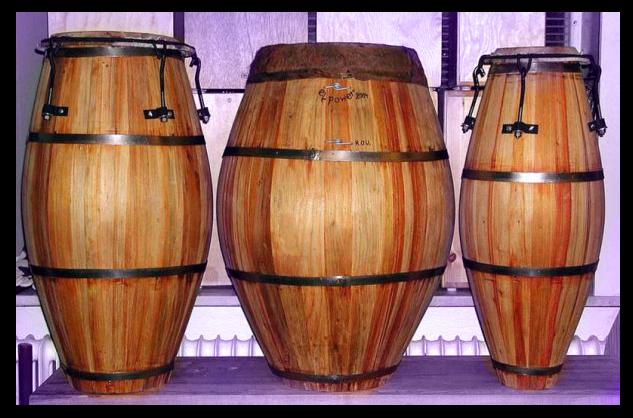
Image in public domain, courtesy of Wikipedia.
Identity in the musical performative nature of candombe is informed by the drums. While the Euro-Uruguayans can identify their European ancestry based on their register of surnames as indicators and further make invisible African history during slavery by imposing their own last names on the slaves, African ancestry is unofficially registered on the drums, which as the Uruguayan musicologist Ahoronián notes, is an underappreciated instrument in Western music as a result of Eurocentrism (2). Playing the drums in the comparsa is to remember the long history of resistance in the Afro-Uruguayan community, from slaves to peons to neo-slaves only allotted servile occupations, as Ferreira finds (81). There their syncopated rhythms tell a story for those initiated to hear it and feel it. In the act, they narrate their own past in the public performance and remember it while they embody it in the same way, expressing in non-verbal communication their past in the ongoing present. Llamadas to this day maintain the distinct rhythms that are inherited from the naciones down to the barrios (Ferreira 131). They are coded calls that members of the community could identify with and respond to. When the three sections of the drums play piano, repique, and chico, it is called a cuerda, it is done in a call – response fashion, and is described as a conversation between the drums. For it to be an authentic performance, there must be a communal energy informed by the collective alliance of performers. It is a ritual with customs that recount a history not inscribed in official discourse, but in the drumming. The three most famous are Ansina, Cuareim, and Cordón.
Toque Ansina
Toque Cuareim
Toque Cordón
When drums are played by the comparsas in candombe, they communicate a culturally rich history, and they are doing much more than entertaining an audience. They are embodying a past of resistance in their performance. In N, there is an incorporation of the body and the app into the music by the creation of the songs in the performance giving a new conception to what it is to be an entertained consumer, actually engaging with the music and environment at an interactive level. The algorithm used to choose the direction leaves the manner in which the distance will be traversed up to the User; because the only thing to be discerned is the direction, the route takes importance over the destination to be reached and as such is experienced as reaching for a means for the means’ sake. N2 treats space as a stage for the journey. Each walk, each frame, is a distance, is an experience. The app as a space is one that asks the User to enter another, to break away from preconceived notions of privilege and proximity to performances, to agency. It appears to be an isolated space, confined to the screen of the phone or tablet, but it transcends, and does so at a very individual level. The experience makes the User question and confront established conceptions, things that he/she might take for granted. The people, the boundaries, and markers of representation are all confronted in the encounters to reveal something about the performance that stays inscribed in the memory of the User. As opposed to being mapped and giving a point of the world an emphasis in a two-dimensional space, the User is made to be the mapping instant, to enter and dwell a space with consideration of those there. Maps imply a sense of dominion, they mark spatial differences better than they do unity and give the creator of the map and the reader of it a privileged place. To hold the world in one’s hands, or read its information is in a manner that bequeaths one self-importance. N2 brings the User back to the three-dimensional world to inhabit that space and displaces notions of hierarchy attached to people and places.
Bibliography
Ahoronión, Coriún. “La musica del tamboril afrouruguayo como hecho historicamente dinámico”. V Jornadas Argentinas de Musicología, INM Carlos Vega, Buenos Aires, 1990. (1-3)
Andrews, George Reid. Blackness in the White Nation: A History of Afro-Uruguay. Chapel Hill: University of North Carolina Press, 2010.
Drexler, Jorge. N. Wake App. Warner Music Spain S.L. Madrid, 2012
Drexler, Jorge. Interview and concert with Lalo Mir. Encuentro en el estudio, temporada 7. Canal Encuentro. Broadcast.
Ferreira, Luis. Los tambores del candombe. Montevideo: Ediciones Colihue-Sepé, 2002.
Biography
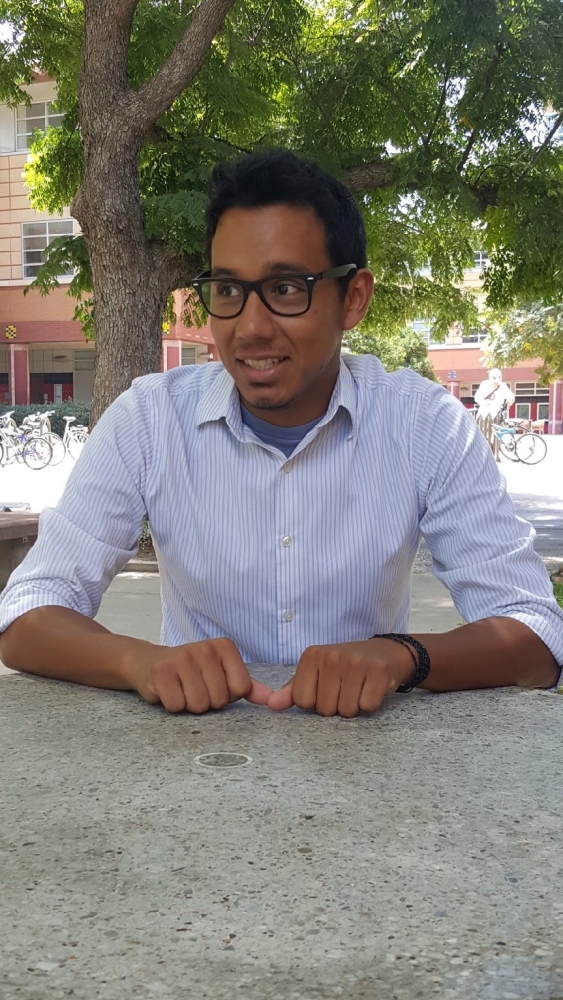
Óscar A. Ulloa is a PhD Candidate in the Hispanic Studies Department at University of California, Riverside. His research interests lie in Southern Cone Culture, particularly where literature, music, and cinema blur their boundaries and intersect. He has been a researcher at the Biblioteca Nacional de Uruguay and the Sección de Archivo y Documentación del Instituto de Letras at the Universidad de la República, in Uruguay.
[i] The 3rd of December 1978 is the day the conventillo Mediomundo was closed and its residents displaced by Uruguay’s civic-military dictatorship. Since 2006 it has been the Official Day of Candombe, Afro-Uruguayan Culture, and Racial Equity in Uruguay.





